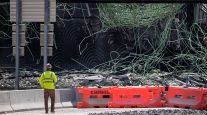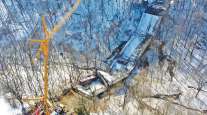Iowa Bridges Get Help Under State Transportation Plan
More than a third of the $3.5 billion Iowa state planners said they intend to spend on transportation needs in the next five years will be devoted to improving bridges.
The seven-member Iowa Transportation Commission approved on June 14 an improvement plan for 2017-2021 that includes expenditures in aviation, transit, railroads, trails and highways to modernize transportation services while enhancing safety.
Of the total, $1.2 billion is slated for investments in Iowa’s state-owned bridges. All told, the plan calls for $1.6 billion in funding toward work on existing infrastructure, including bridges and highways.
“I would say, over the last several programs, there has been increased emphasis not only on bridges, but also on existing infrastructure,” said Stuart Anderson, director of the Iowa Department of Transportation’s planning, programming and modal division. “That definitely has been a priority for them.”
The five-year plan includes a $36.5 million investment in non-interstate bridges for fiscal year 2017. That number increases annually up to $55 million in 2021.
Iowa’s bridges could use some work, according to a 2015 National Bridge Inventory report released earlier this year.
The report, which used Federal Highway Administration data, found that Iowa ranks worst in the nation for the total number of bridges considered deficient, and third-worst for the percentage of deficient bridges in a state’s overall inventory.
Of Iowa’s 24,242 bridges, 5,025 — or nearly 21% — are considered structurally deficient, according to the report.
The five-year plan also contains a number of high-profile projects in the Corridor that previously had been announced and were expected to be approved in the final draft — including a new Interstate 380 interchange at Forevergreen Road in fast-growing North Liberty; a massive overhaul of the I-380/I-80 interchange; an extension to Highway 100 around Cedar Rapids; and a new Mount Vernon/Lisbon bypass on Highway 30.
Anderson said the state’s 10-cents-per-gallon gas tax increase — approved in February 2015 — has helped generate added funds for bridge and highway needs.
A combination of the gas tax proceeds, vehicle registration fees and disbursements from the federal transportation budget pays for the plan.
To complete so many projects, the five-year plan is 9% larger than the $3.2 billion 2016-2020 plan.
That funding has been used to add more projects to the list and fast-track some high priority projects, Stuart said — such as speeding up work on the Forevergreen Road ramp to begin in 2018, ahead of the major I-380/I-80 interchange replacement.
“They’ve been able to not only increase investment in modernization of bridges and pavements, but also they’ve been able to add in some corridor completion projects,” Anderson said.



